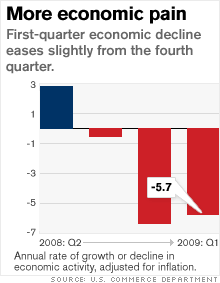Economy shrinks at 5.7% rate
First-quarter GDP contraction is revised to narrower annual rate, but decline remains the second largest in 27 years.

NEW YORK (CNNMoney.com) -- The U.S. economy shrank at an annual pace of 5.7% in the first quarter, a less severe drop than initially reported but still the second-biggest quarterly decline in 27 years, the government said Friday.
Economists expect a drop in gross domestic product this quarter as well, although not as sharp as in the first three months of the year.
Last month, the government initially reported that gross domestic product -- the broadest measure of the nation's economic activity -- fell at an annual rate of 6.1%.
The revision fell short of economists' expectations of a 5.5% drop, according to a consensus estimate from Briefing.com.
The first quarter of 2009 marked the third quarter in a row that the economy has contracted. It was the second worst drop in the measure since the early 1980s -- behind only the fourth quarter of 2008, when GDP plunged at an annual pace of 6.3%.
Inventories weigh in: Much of the revision in first-quarter GDP was attributed to a lower reading in business inventories, as sales of domestic products were unchanged at a 3.4% annual rate of decline.
Inventories fell by $91.4 billion, compared to an initial reading of $103.7 billion. As a result, the subtraction to the annual rate of GDP growth was 2.3 percentage points, rather than 2.8.
Businesses cut their inventory levels in the face of falling demand. A cutback in inventory levels means that when the economy does start to recover, businesses will have to start producing goods again to meet demand.
So, since inventories didn't decline as much, what may have been a positive in the first quarter may not be in the second, said Brian Bethune, chief financial economist at IHS Global Insight.
"The basic problem is there is very weak demand for goods and services, not only in the U.S., but around the world," said Bethune. "If you combine that with excess inventories, then you have a major problem."
In the first quarter, spending by individuals was revised lower to a rate of 1.5% growth, down from the initially reported 2.2% rate. Residential investment plunged by 38.7% in the quarter.
The recession has cut into demand for goods and services. The unemployment rate, which reached a 25-year high of 8.9% in April, has caused anxious consumers to cut back.
Going forward: Ian Shepherdson, chief U.S. economist at High Frequency Economics, said in a research letter does not think that the cut back in inventories is enough to support a rebound in the second half of this year. But, he wrote, "the speed of the drop will slow."
"We expect Q2 GDP of about minus 2%," Stephenson said.
Bethune also forecast that second-quarter GDP would remain under pressure.
"If you look at key leading indicators on spending -- auto sales are very weak, chain store sales are weak -- so consumer spending is not going to really do much," he said. Furthermore, "business investment is going to contract because corporate profits continue to be under pressure."
While corporate profits increased by $42.6 billion in the first quarter, those profits were isolated to the financial sector, according to the report. Profits of financial companies increased $116.1 billion in the quarter, while profits in non financial companies decreased by $64.2 billion.
Bethune said that he expects to see GDP nearly break even in the third quarter and finally turn to a modest positive in the final quarter of the year.
The government's final revision of first-quarter GDP is due June 25. ![]()


